Welcome, fellow food enthusiasts! As your guide to the world’s most captivating flavors and cultures, I’m thrilled to dive deep into one of my favorite culinary destinations: Hanoi. This ancient capital of Vietnam is a city where history whispers from every corner and the aroma of incredible food drifts through the air. Exploring Hanoi Food Specialties isn’t just about eating; it’s a journey into the soul of a vibrant culture.
Having spent countless hours navigating the city’s bustling streets and hidden alleys, tasting dishes passed down through generations, I can tell you that Hanoi’s food scene is truly exceptional. It reflects centuries of history, influences from its neighbors and former rulers, and the ingenuity of local cooks who transform simple ingredients into extraordinary meals. Let’s embark on a delicious adventure to discover the most iconic Hanoi Food Specialties that capture the essence of this enchanting city.
Discovering the Rich World of Hanoi Food Specialties
Hanoi’s culinary landscape is incredibly diverse, offering everything from steaming noodle soups to savory grilled meats and delicate rice cakes. Each dish tells a story, often rooted in tradition, seasonal ingredients, and local customs. These are the essential Hanoi Food Specialties you absolutely must seek out during your visit. They represent the heart and soul of Hanoian cuisine, perfected over time and beloved by locals and visitors alike.
Pho Bo: Hanoi’s Soulful Beef Noodle Soup
No discussion of Hanoi Food Specialties can begin without Pho Bo. This isn’t just food; it’s an institution, a source of national pride. While its origins might lie elsewhere in Vietnam, Hanoi is widely regarded as the place where Pho reached its pinnacle. The magic is in the broth – a complex, aromatic symphony achieved by simmering beef bones with spices like star anise, cinnamon, ginger, and cloves for hours.
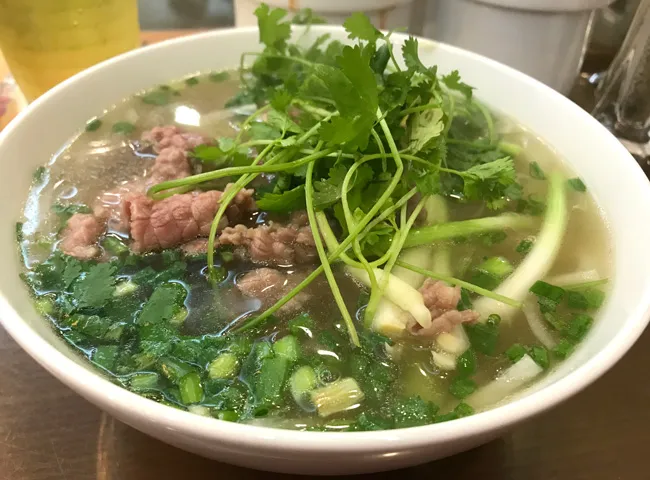 A steaming bowl of Pho Bo, a classic Hanoi Food Specialty, served with herbs and lime.
A steaming bowl of Pho Bo, a classic Hanoi Food Specialty, served with herbs and lime.
A typical bowl features soft rice noodles, thinly sliced rare or cooked beef, and a scattering of fresh herbs and chopped green onions. It’s traditionally a breakfast dish, fueling Hanoians for their day, but you’ll find it served around the clock now. My personal ritual involves adding a squeeze of lime, a dash of chili paste, and a splash of rice vinegar to cut through the richness. It’s a simple addition that elevates the already incredible flavor profile. Trying Pho Bo in Hanoi is an absolute non-negotiable experience. One popular spot locals often mention is Pho Gia Truyen on Bat Dan Street, famous for its rich, traditional broth, though be prepared for a queue!
Bun Cha: The Iconic Grilled Pork and Noodle Delight
If Pho rules the morning, Bun Cha reigns supreme at lunchtime in Hanoi. This delightful dish captures the essence of Vietnamese street food culture. It consists of a bowl of dipping sauce – a delicate balance of sweet, sour, salty, and savory fish sauce – filled with tender, charcoal-grilled pork patties and slices of fatty pork belly. Pickled green papaya or kohlrabi adds a refreshing crunch.
Top 15+ Ideas for Unforgettable Family Fun Los Angeles
Discover the Best Backpacking in Michigan – Unforgettable Trails & Adventures
Discover the Best Time to Visit Denver – A Seasonal Guide 2025
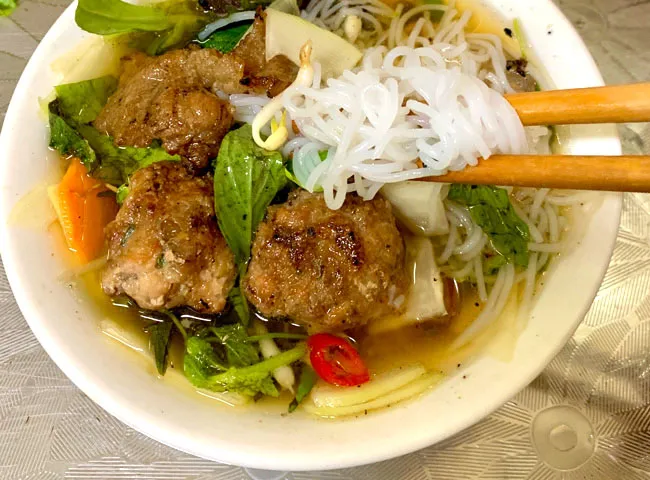 Bun Cha, a beloved Hanoi Food Specialty, featuring grilled pork patties in broth with vermicelli noodles and fresh greens.
Bun Cha, a beloved Hanoi Food Specialty, featuring grilled pork patties in broth with vermicelli noodles and fresh greens.
Bun cha is served with a generous plate of rice vermicelli noodles (Bun) and a basket overflowing with fresh herbs like perilla, coriander, and lettuce. The ritual is to dip the noodles and herbs into the flavorful pork broth.
You’ll often see smoky grills on street corners around noon – that’s your sign you’re near a Bun Cha spot! The aroma of grilling pork is incredibly enticing. I make it a point to have Bun Cha at least once a week; that smoky, savory grilled pork is truly addictive. Don’t forget to load up on the fresh herbs – they add layers of freshness and aroma that cut through the richness of the pork. Fried crab spring rolls (Nem Cua Be) are a highly recommended optional addition!
Bun Thang: The Elaborate “Herbal Medicine” Noodle Soup
Bun Thang is one of the more intricate and visually appealing Hanoi Food Specialties. Its name, loosely translating to “herbal medicine soup,” refers to the numerous precisely prepared ingredients layered atop the rice vermicelli noodles, reminiscent of the small portions in a traditional herbal medicine bundle. The base is a clear, refined chicken or sometimes pork broth.
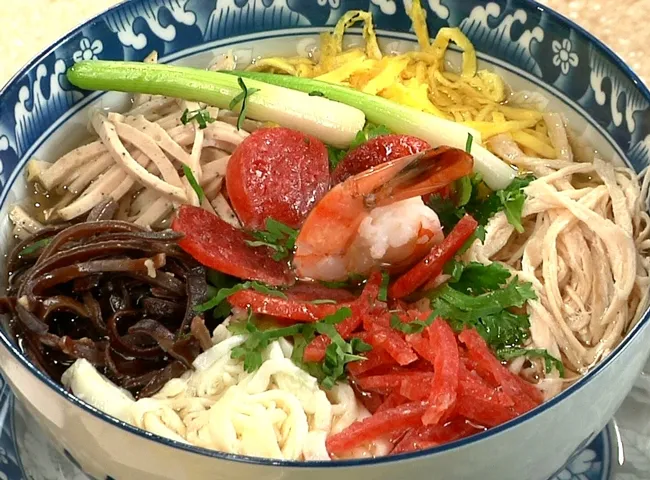 An intricate bowl of Bun Thang, a delicate Hanoi Food Specialty with multiple toppings and clear broth.
An intricate bowl of Bun Thang, a delicate Hanoi Food Specialty with multiple toppings and clear broth.
The toppings are key: finely shredded chicken, thin strips of Vietnamese ham (gio lua), julienned fried egg crepe, dried shrimp floss, shiitake mushrooms, and sometimes pickled radish. It’s garnished with fresh herbs like Vietnamese coriander and green onions, and often a few chili slices. Bun Thang is known for its subtle, balanced flavors, which is why it’s typically served with condiments like lime, chili sauce, and particularly, a tiny amount of shrimp paste (mam tom). While pungent on its own, a touch of good quality shrimp paste adds a deep, earthy umami that transforms the broth.
Bun Ngan: Muscovy Duck Noodle Soup
While Bun Cha dominates lunch, Bun Ngan often steps into the spotlight for dinner and late-night cravings. This lesser-known gem among Hanoi Food Specialties offers a comforting and savory experience centered around Muscovy duck. The soup features tender slices of boiled duck and bamboo shoots in a flavorful broth, served over rice vermicelli noodles.
You’ll find Bun Ngan vendors setting up shop in the late afternoon, often staying open past midnight, making it a perfect late-night bite after exploring the city. It’s a dish that feels uniquely Hanoian and is less commonly found in other parts of Vietnam. The best place to sample authentic Bun Ngan is often within the bustling streets of the Old Quarter, where some vendors have perfected the duck broth over years. A variation, Mien Ngan, uses cellophane noodles instead of vermicelli.
Banh Mi: The Iconic Vietnamese Baguette
The Banh Mi stands as a delicious testament to Hanoi’s colonial past and its ability to adapt foreign influences into something uniquely Vietnamese. While the French introduced the baguette, Hanoians, and Vietnamese across the country, transformed it into a culinary masterpiece. The Hanoi version typically focuses on classic, rich fillings.
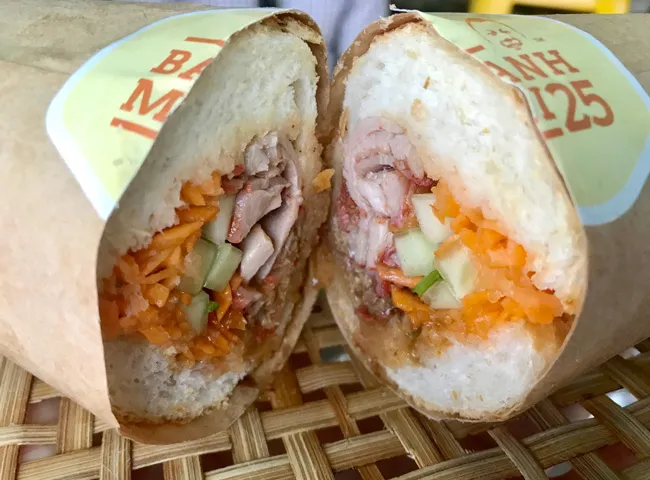 A delicious Vietnamese Banh Mi, a popular Hanoi Food Specialty reflecting French influence with local fillings.
A delicious Vietnamese Banh Mi, a popular Hanoi Food Specialty reflecting French influence with local fillings.
Crispy baguette is filled with a layer of homemade pork liver pâté, various cold cuts (like Vietnamese ham and headcheese), roasted pork or chicken, pickled carrots and daikon, cucumber slices, cilantro, and a drizzle of chili sauce or mayonnaise. The combination is an explosion of textures and flavors – crispy bread, rich pâté, savory meat, tangy pickles, fresh herbs, and spicy heat. It’s a perfect, portable meal available everywhere from simple carts to cafes. Banh Mi 25 is a famous spot often recommended for first-timers, offering a variety of filling options. It’s a simple yet profoundly satisfying part of exploring Hanoi Food Specialties.
Cha Ca: The Sizzling Turmeric Fish with Dill
Cha Ca is perhaps the most historically significant and uniquely Hanoian dish on this list. It’s said to have originated over a century ago with the Doan family, who served this specific dish to resistance fighters. It became so popular that the street where their restaurant is located was eventually named Cha Ca Street after the dish itself. This level of historical significance makes Cha Ca a must-try among Hanoi Food Specialties.
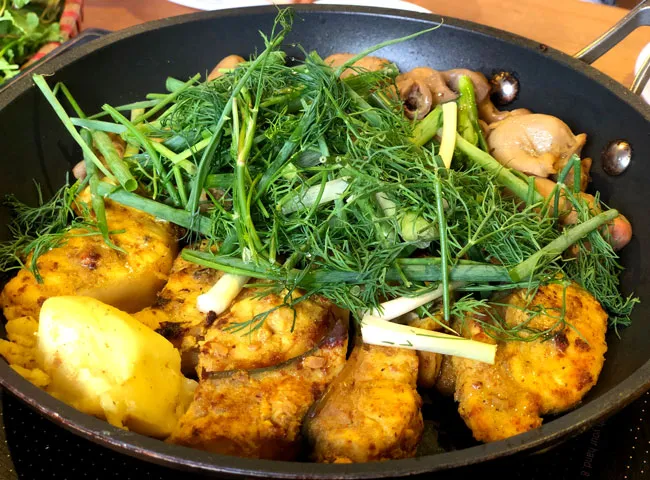 Cha Ca, a historic Hanoi Food Specialty of turmeric-grilled fish with dill, served at the table.
Cha Ca, a historic Hanoi Food Specialty of turmeric-grilled fish with dill, served at the table.
The dish features firm white fish (often catfish or snakehead fish) marinated in turmeric, galangal, and other spices. It’s brought to your table with a sizzling pan, where it’s cooked further with copious amounts of fresh dill and green onions. You then combine the hot fish and herbs with rice vermicelli noodles, roasted peanuts, fresh herbs (like perilla and mint), and a dipping sauce. The aroma of the sizzling turmeric and dill is intoxicating. While the original Cha Ca La Vong is legendary, other places like Cha Ca Thang Long also serve excellent versions. This is an interactive and incredibly flavorful dining experience unique to Hanoi.
Banh Com: The Sweet Young Sticky Rice Cake
Moving into the realm of sweets and snacks, Banh Com holds a special place among Hanoi Food Specialties, particularly as a traditional gift and celebratory treat. Made from young, green sticky rice (com), it has a distinctive chewy texture and a subtle, earthy aroma. The filling is typically a smooth, sweet paste made from mung beans, often mixed with grated coconut and sometimes lotus seed jam.
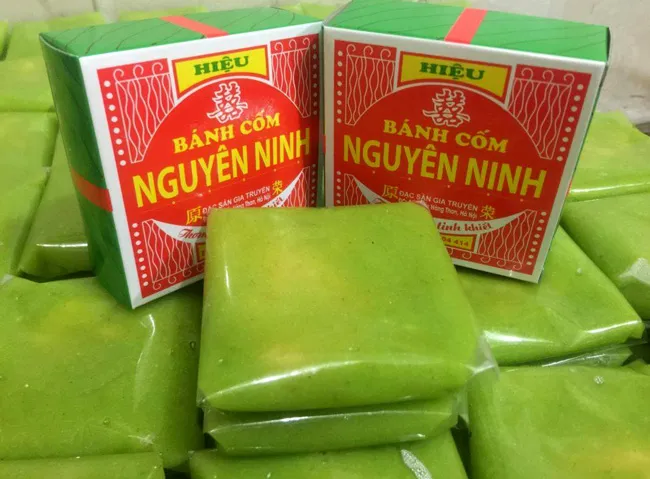 Traditional Banh Com, a sweet and chewy Hanoi Food Specialty made from young sticky rice and mung bean.
Traditional Banh Com, a sweet and chewy Hanoi Food Specialty made from young sticky rice and mung bean.
Banh Com is wrapped in green dong leaves or banana leaves, which impart a faint, pleasant fragrance. It’s a customary item presented during engagement and wedding ceremonies in Northern Vietnam. The texture is unique – slightly elastic and sticky. It pairs beautifully with a cup of hot Vietnamese tea, making it a perfect afternoon snack. Hang Than street is particularly famous for Banh Com shops, with Nguyen Ninh being one of the oldest and most respected producers. Trying Banh Com offers a taste of Hanoi’s sweeter, more traditional side.
Banh Cuon: Delicate Steamed Rice Noodle Rolls
Banh Cuon is another popular breakfast item and a delicate example of Hanoi Food Specialties. These are incredibly thin, wide sheets of steamed rice batter, so translucent they are almost ethereal. The batter is made from fermented rice and steamed quickly on a cloth stretched over boiling water, requiring considerable skill.
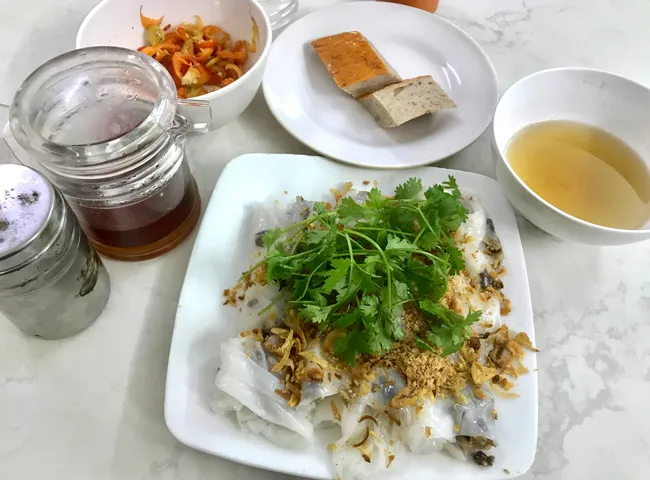 Freshly steamed Banh Cuon, a delicate Hanoi Food Specialty filled with pork and mushrooms, served with dipping sauce.
Freshly steamed Banh Cuon, a delicate Hanoi Food Specialty filled with pork and mushrooms, served with dipping sauce.
The rolls are typically filled with a savory mixture of seasoned ground pork, minced wood ear mushrooms, and fried shallots. They are served topped with more crispy fried shallots and fresh herbs, accompanied by a dipping sauce (nuoc cham). This sauce is usually a mix of fish sauce, sugar, lime juice, and water, often with a drop of ca cuong essence (from giant water bugs), which provides a unique, subtle aroma. Banh Cuon is light yet satisfying, a graceful part of Hanoi’s culinary repertoire. Eating Banh Cuon often evokes nostalgic memories for many Vietnamese, including myself, recalling market visits with family.
Caphe Trung: Hanoi’s Famous Egg Coffee
Stepping away from savory dishes, Caphe Trung, or Egg Coffee, is a unique and delightful beverage that has become synonymous with Hanoi. Invented in the 1940s by Mr. Giang, during a time when milk was scarce, he ingeniously combined whisked egg yolk with sweetened condensed milk to create a creamy, frothy topping for Vietnamese coffee. The result is a surprisingly harmonious blend.
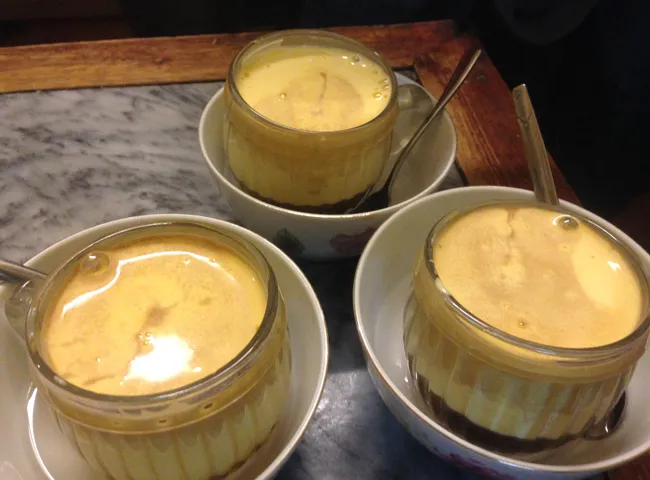 Caphe Trung, or Egg Coffee, a unique Hanoi Food Specialty with creamy egg foam topping strong Vietnamese coffee.
Caphe Trung, or Egg Coffee, a unique Hanoi Food Specialty with creamy egg foam topping strong Vietnamese coffee.
The strong, dark Vietnamese coffee provides a robust base, while the sweet, velvety egg foam floats on top, creating layers of flavor and texture. Many describe the taste as similar to liquid tiramisu or a rich custard. It’s often served in a small bowl of hot water to keep the drink warm. Café Giang, established by the inventor, is the original and most famous place to try Egg Coffee, although many cafes in Hanoi now offer it. It’s a must-try experience, even if you’re not a coffee drinker, and a perfect example of innovation within Hanoi Food Specialties. Beyond coffee, Café Giang now offers egg matcha, egg chocolate, and even egg beer!
Kem Trang Tien: A Taste of Hanoi Nostalgia
While not a complex gourmet dessert, Kem Trang Tien holds a special, nostalgic place in the hearts of Hanoians and deserves its mention among Hanoi Food Specialties. Located near the Hanoi Opera House, this ice cream shop has been an institution since 1958. It’s a simple, no-frills experience focused purely on the ice cream itself.
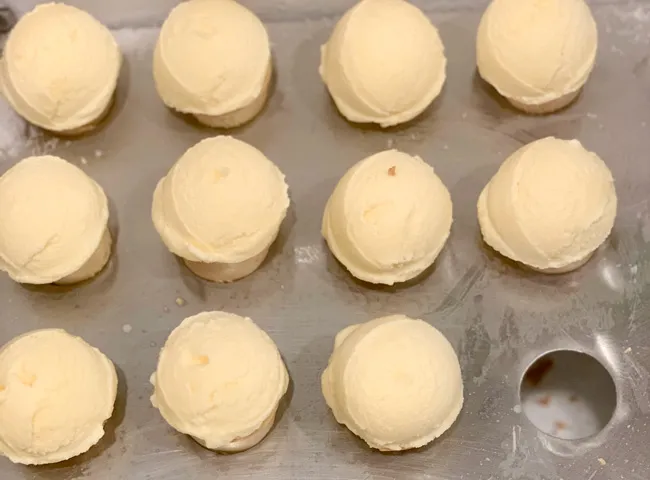 Enjoying Kem Trang Tien ice cream, a beloved Hanoi Food Specialty near the Opera House.
Enjoying Kem Trang Tien ice cream, a beloved Hanoi Food Specialty near the Opera House.
You join a bustling queue, make your choice from various flavors (green sticky rice/com, coconut, chocolate, vanilla) in cone or stick form, pay, and receive your treat directly from freezers. The ice cream is known for being slightly icy rather than creamy, but it’s refreshing, has distinct flavors, and offers a perfect simple sweetness. Visiting Kem Trang Tien, especially on a warm evening or weekend, is a classic Hanoian experience filled with chatter and laughter. It’s more about the atmosphere and the shared memory than just the dessert itself – a sweet conclusion to exploring the diverse range of Hanoi Food Specialties.
More Than Just Food: The Cultural Tapestry of Hanoi’s Culinary Scene
These Hanoi Food Specialties are more than just dishes; they are woven into the fabric of daily life and culture. They reflect the city’s history – from the agrarian roots seen in the focus on rice noodles to the French colonial influence in Banh Mi. They represent community, from the shared experience of eating Bun Cha on the sidewalk to gathering for a bowl of Pho with family.
The care and tradition that go into preparing these foods, often using techniques passed down through generations, speak to a deep respect for culinary heritage. Exploring Hanoi Food Specialties allows you to connect with the city’s past and present, understanding how food serves as a vital link in preserving cultural identity and creating shared experiences.
Planning Your Culinary Adventure: Tips for Trying Hanoi Food Specialties
Ready to dive in? Here are a few tips for making the most of your food journey through Hanoi:
- Embrace Street Food: Many of the best Hanoi Food Specialties are found at humble street stalls or small, family-run eateries. Don’t be afraid to venture beyond formal restaurants. Look for places with a crowd – that’s usually a sign of deliciousness.
- Try Different Times of Day: As we’ve seen, some dishes are traditionally associated with breakfast (Pho, Banh Cuon), lunch (Bun Cha), or dinner/late night (Bun Ngan). Spread out your culinary exploration throughout the day.
- Don’t Be Shy with Condiments: Vietnamese food is often served with a range of herbs, chilies, lime, vinegar, and sauces. These are meant to be added to customize the dish to your preference. Experiment!
- Ask Locals: If you can, ask Hanoians for their favorite spots. They often know the hidden gems.
- Consider a Food Tour: A guided food tour with a local expert can be invaluable for navigating the options, understanding the history, and finding the very best places, especially when exploring diverse Hanoi Food Specialties.
Frequently Asked Questions About Hanoi Food Specialties
Q: Are all these dishes only found in Hanoi?
A: While some dishes like Cha Ca and Bun Ngan are uniquely Hanoian or perfected there, others like Pho and Banh Mi are found throughout Vietnam, but the Hanoi versions often have distinct characteristics and preparations that set them apart and make them famous.
Q: Is it safe to eat street food in Hanoi?
A: Generally, yes, if you choose wisely. Look for busy stalls with high turnover, indicating fresh ingredients. Observe basic hygiene practices at the stall. Your stomach will likely adjust, but many travelers enjoy street food without issue.
Q: What is the best time of year to visit Hanoi for food?
A: Hanoi’s food is available year-round. However, the cooler, drier months from September to November or March to April can be more comfortable for walking and eating outdoors. Some seasonal ingredients might be available at specific times.
Conclusion
Exploring Hanoi Food Specialties is an unforgettable experience that stimulates the senses and deepens your appreciation for Vietnamese culture. From the comforting depth of Pho Bo to the vibrant sizzle of Cha Ca and the delicate sweetness of Banh Com, each dish offers a unique window into the city’s past and present. It’s a culinary journey that satisfies not just your hunger but your curiosity about the world. If you’re seeking an adventure that combines incredible flavors, rich history, and genuine local experiences, look no further than the remarkable Hanoi Food Specialties. Prepare to eat, explore, and fall in love with this city, one bite at a time.
